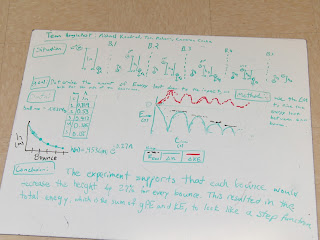The premise of the quick lab is to design, carry out, analyze, and present an experiment during a single 90-minute class period. Presentations should be a single whiteboard.
The experiments:
Alex, Alex, Brandon
- They took video of basketball shots, from launch to floor, and used video analysis to determine how much energy the net (all were 'swishes,' of course) took from the ball as it went through.
- Revisions: initially using the first two points of the video to determine the launch velocity gave unrealistically high results, so they changed that part of the analysis to use kinematics to analyze the change in horizontal and vertical position and time taken (all easily measured from the video) from launch to goal in order to find the launch velocity.
- The boards (yes, they cheated and used two!):
Kawala and Kati
- They slid a small whiteboard eraser down a ramp, after which it plunged to the floor. To determine the coefficient of kinetic friction between the ramp and the block, they used the fall distance and how far away the eraser landed from the table, along with the ramp length and angle. This required marrying kinematics, conservation of energy, and the work-energy theorem, and 2.5 gallons of algebra.
- Revisions: they used two different 'floors' to take data, having the eraser hit the actual floor in one trial and hit a crate sitting on the floor in another trial. The advantage of this is that we can find errors by looking at the trend in the data as the height of the floor is varied. This is a great check that nothing unexpected is going on, and it was a good thing, because the first value was reasonable, but there were a few little errors to be uncovered. The coefficients came out negative when the height was changed, so it gave a prompt to find the issues, and now they're confident in these numbers!
- The boards (also two!):
Cam, Mike, and Toru:
- These guys took some high-speed video as well, analyzing the heights of a bouncing ping-pong ball. In addition to modeling the height of the ball as a function of bounce (and making a slick argument that the exponential function implies a constant-percentage loss of energy (rather than a constant amount of energy lost), they used Logger Pro to graph the gravitational PE, kinetic energy, and total energy as a function of time, showing the expected constant total energy during each flight (well, a slight decline due to air resistance), with "steps down" in total energy following each bounce.
- Revisions: after considering the parallax issue with measuring the height of the bouncing ball moving in front of a meter stick (especially with the camera mounted to a tripod), they instead dropped the ball next to the meter stick, eliminating the point-of-view issue.
- The board:





No comments:
Post a Comment